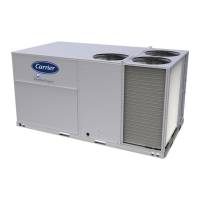29
Return Enthalpy (RETURN ENTHALPY). Enthalpy Lockout
(ENTHALPY LOCKOUT) occurs when any of the following
are true:
• When Differential Enthalpy Control is disabled (DIFF
ENTHALPY CTL = Disable) and the outdoor enthalpy
(OUTDOOR ENTHALPY) is greater than the Maximum
Outdoor Enthalpy limit (ENTHALPY HI LIMIT).
• When Differential Dry Bulb Control is enabled (DIFF
DRY BULB CTL = Enable) and the outdoor enthalpy
(OUTDOOR ENTHALPY) is greater than the return en-
thalpy (RETURN ENTHALPY). The Differential Enthal-
py deadband (ENTHALPY DEADBAND) is used in the
case of unlocking the Enthalpy lockout (ENTHALPY
LOCKOUT).
• The Enthalpy switch input (ENTHALPY SWITCH) is
reading high.
Unoccupied Free Cooling Lockout
Unoccupied Free Cooling lockout (UFC LOCKOUT?) occurs
when the unit is in the unoccupied period (OCCUPIED NOW?
= No) and the Outdoor Air Temperature (OUTDOOR AIR
TEMP) is less than the Unoccupied Free Cooling low tempera-
ture (UFC LOW TEMP).
UNOCCUPIED FREE COOLING
The unoccupied free cooling algorithm attempts to maintain
the building space half way between the Occupied Cool Set
Point (OCC COOL SETPOINT) and Occupied Heat Set Point
(OCC HEAT SETPOINT) using only the economizer when
the conditions in the building and the outdoors are suitable,
during unoccupied periods. Three different points define this
algorithm: Unoccupied Free Cooling configuration (WHEN
TO UNOCC FC), Free Cooling Preoccupancy Time configura-
tion (UFC PREOCC TIME), and Free cooling allowed (OK
TO FREE COOL?).
WHEN TO UNOCC FC = 0 (Disabled)
Free Cooling will only occur if the space exceeds the unoccu-
pied setpoints.
WHEN TO UNOCC FC = 1 (Preoccupancy)
Unoccupied free cooling can only occur when the time until
the next occupied period is less than the Unoccupied Free Cool
Pre-Occupancy Time (UFC PREOCC TIME) in minutes.
WHEN TO UNOCC FC = 2 (Unoccupied)
Unoccupied free cooling can occur throughout the entire unoc-
cupied period. The space temperature must be higher than the
mid-point between the occupied cooling and heating setpoints.
Power Exhaust
Power Exhaust is a function used to assist in the building ex-
haust air if the barometric relief damper is not enough. It can
be one or two motors which can be controlled independently to
provide 2 stages of exhaust. These two power exhaust stages
are controlled by relays on the Main Base board, and therefore
need to be configured on relay channels. To assign the channels
set the PE1 RELAY CHANNEL and PE2 RELAY CHANNEL
as needed.
NOTE: Factory installed power exhaust is only one channel and is
on Relay 06.
When a power exhaust 1 relay channel is configured, the con-
trol will create a PE1 curve (see Fig. 20). This curve is created
by applying the difference of the power exhaust stage 1 at max-
imum fan speed (PE1 POS @ MAX SPD) and the Economizer
minimum at maximum fan speed (MIN POS @ MAX FAN) in
relationship to the minimum position curve. When a power ex-
haust 2 relay channel is configured, the control will create a
PE2 curve (see Fig. 20). This curve is created by applying the
difference of the power exhaust stage 2 at maximum fan speed
(PE2 POS @ MAX SPD) and the Economizer minimum at
maximum fan speed (MIN POS @ MAX FAN) in relationship
to the minimum position curve.
Power exhaust 1 (PE1 RELAY) and power exhaust 2 (PE2
RELAY) are controlled using their respective curves as a
threshold. When the operating point of the Commanded Fan
Speed (IDF SPEED OUTPUT) and Economizer Commanded
Position (ECON CMD POSITION) is above the power ex-
haust 1 curve, Power exhaust 1 (PE1 RELAY) will be turned
on. When the operating point falls below the curve minus the
power exhaust turn off deadband (PE OFF DEADBAND), the
Power exhaust 1 (PE1 RELAY) will be turned off. Power ex-
haust 2 operates the same as Power exhaust 1, except using the
PE2 curve.

